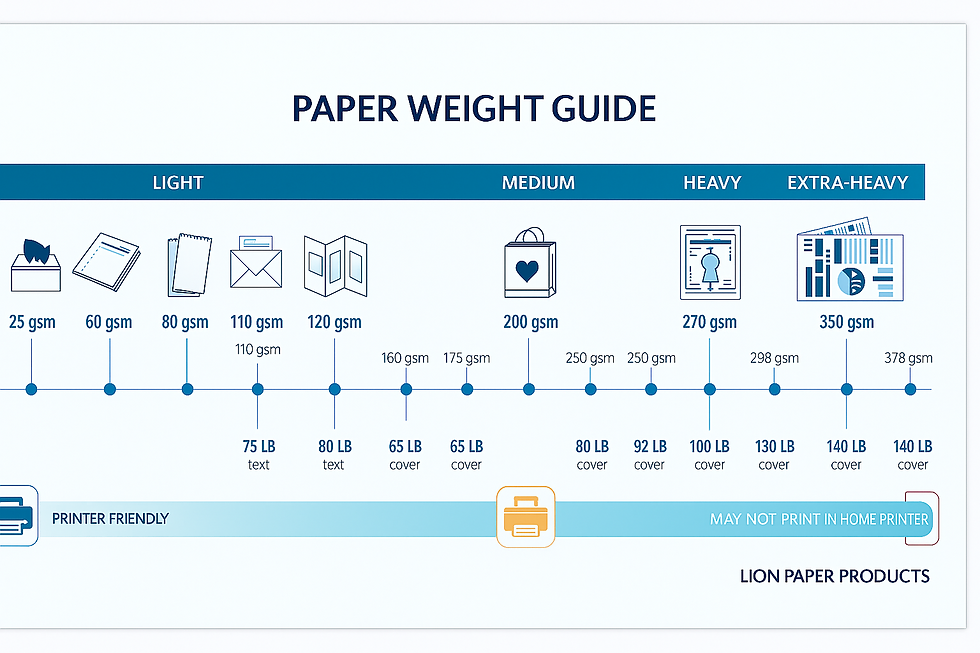Paper Weight Guide (GSM): How to Choose the Right Paper Every Time
- Lion Paper Team

- Jun 9, 2025
- 3 min read
Updated: Aug 14, 2025
Related video cited from Youtube:
Quick Content Reach:
Understanding paper weight isn't just technical—it's practical. Whether you're sourcing custom notebooks, selecting paper for brochures, or printing high-end invitations, the weight of the paper affects feel, quality, compatibility, and cost.
What Is Paper Weight?
Paper weight refers to the thickness and density of a sheet, commonly measured in GSM (grams per square meter) or LBS (pounds per 500 sheets). The heavier the paper, the thicker and stiffer it usually is. But not all paper weights are equal — the base size and type of paper stock also play a critical role.

GSM vs LBS: Key Differences
GSM (Grams per Square Meter): Universal measurement standard outside the U.S.
Lightweight: 60–90 GSM — used in notebooks, mass-market books
Medium weight: 100–200 GSM — good for brochures, folded mailers
Heavyweight: 200–400 GSM — used for postcards, packaging, business cards
LBS (Pound System): Common in North America. Depends on paper type & sheet size.
Text Paper: 20–70 lb — internal pages, general commercial printing
Cover Paper: 65–120 lb — covers, folders, thick cards
Index/Tag Paper: 90–150 lb — signage, durable printed cards
Common Paper Weight Conversion Chart
Paper Type | LBS | GSM Approx. | Common Uses |
Bond | 20 lb | 75 GSM | Office paper, printer paper |
Text | 70 lb | 104 GSM | Booklets, brochures |
Cover | 80 lb | 216 GSM | Business cards, covers |
Index | 110 lb | 199 GSM | Postcards, dividers |
Tag | 100 lb | 271 GSM | Tags, thick cards |
How to Measure Paper Weight
GSM Calculation: Cut the sheet to 1m² and weigh it. This gives the GSM directly.
LBS Measurement: Weigh 500 sheets of the paper's base size. The result is expressed in pounds.
Caliper Thickness: Use a micrometer to measure paper thickness. Helps differentiate textured vs coated stocks.

Paper Thickness (Caliper) Explained
Caliper is the physical thickness of paper measured in points or microns.
1 point (pt) = 0.001 inches
1 micron = 0.001 millimeter
Why it's important: Two papers with the same GSM can feel very different depending on finishing — glossy, matte, embossed, or textured.
Choosing the Right Paper Weight for Your Project
Use Case | Recommended GSM | Reason |
Notebook pages | 80–90 GSM | Prevents ink bleed, ideal for writing |
Business cards | 250–350 GSM | Durable, conveys premium branding |
Invitations | 270–300 GSM | Luxurious and rigid presentation |
Brochures | 120–160 GSM | Foldable yet strong for color print |
Packaging boxes | 300–400 GSM | Strong support and protection |
Conclusion
Choosing the right paper weight means balancing aesthetics, durability, functionality—and often sustainability. Understanding GSM and LBS helps buyers create specs, reduce risk, and improve user experience.
FAQs:
Q1: Is higher GSM always better?
A: Not necessarily. High GSM adds cost and may be unsuitable for folding or binding.
Q2: Why do two papers with the same GSM feel different?
A: Because of finishing (gloss, matte), fiber type (wood pulp, recycled), and density.
Q3: How to choose GSM for eco-friendly notebooks?
A: Go for 80–100 GSM FSC-certified or PCW recycled papers for balance of printability and sustainability.
Are you looking for a reliable manufacturer? Reach out to Lion Paper for a free quote and consultation. Let’s collaborate on creating custom writing paper products that will set your brand apart from the competition.





Comments